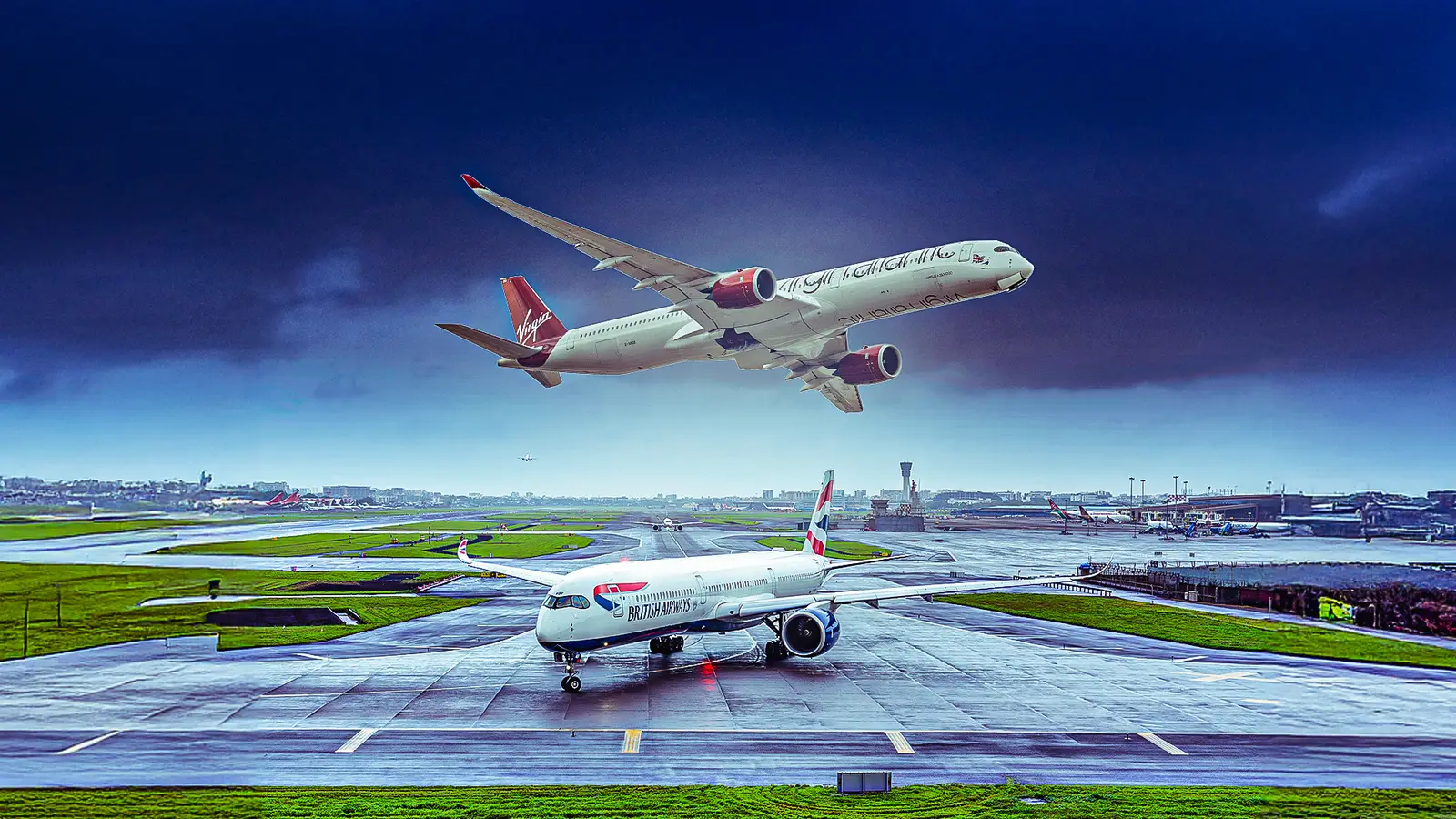Copyright Simple Flying

For many travelers, especially those flying between the United Kingdom and the United States, British Airways and Virgin Atlantic are the dominant names in transatlantic aviation. Both airlines are symbols of British long-haul service excellence, but they serve slightly different passenger segments and strategic goals. Whether you're a frequent flyer choosing a loyalty program, an analyst tracking airline capacity, or a traveler seeking the most options, understanding which carrier leads the transatlantic market is key. Using data for November 2025 from Cirium: Market Intelligence reports, this article compares both airlines’ scheduled passenger flights between Europe and the United States . We’ll analyze total flight counts, seat capacity, routes, and contributing factors like alliances, fleet size, and US gateway presence. By the end, you’ll know not only which airline flies more transatlantic routes, but why that’s the case and what it reveals about the broader UK–US aviation landscape. Flight Volumes And Seat Capacity On Transatlantic Routes According to Cirium Market Intelligence , British Airways operates 2,368 scheduled passenger flights between Europe and the United States in November 2025, while Virgin Atlantic operates 1,152. In seat capacity terms, British Airways offers 665,340 seats, compared to 324,392 for Virgin Atlantic. This gives British Airways a decisive lead, roughly double the number of flights and total available seat miles (ASMs). The result underscores the structural difference between the two airlines. British Airways, with a massive long-haul fleet and deep integration into the oneworld transatlantic joint venture, focuses on scale and frequency. Virgin Atlantic, by contrast, operates within the SkyTeam alliance alongside Delta Air Lines, focusing on select high-yield routes and a premium experience rather than sheer volume. This pattern is consistent with long-term trends. Since the early 2000s, British Airways has been the UK’s largest carrier to the US, leveraging Heathrow’s global hub status. Virgin, while smaller, has consistently maintained a strong brand presence, especially on leisure-heavy routes like Orlando, Miami, and Las Vegas. Understanding The Operational Differences Between The Two Airlines Several interrelated factors explain why British Airways operates significantly more transatlantic flights than Virgin Atlantic, extending beyond mere size to encompass strategic differences in their business models, global alliances, and operational footprints. Although both airlines hail from the UK and focus on premium transatlantic travel, British Airways' evolution as part of the International Airlines Group ( IAG) has positioned it as a powerhouse with a vast network, whereas Virgin Atlantic maintains a more boutique, customer-centric approach that prioritizes quality over quantity. This disparity results in British Airways handling a much larger volume of crossings: for instance, in peak periods like May 2025, British Airways offered over 2.1 million outbound seats from London Heathrow alone, dwarfing Virgin's capacity. To understand this better, let's analyze key elements, weaving in how they interplay to give British Airways its edge. Fleet size and aircraft mix: British Airways' fleet stands at approximately 299 aircraft as of October 2025, including a mix of Airbus A350s, Boeing 787s, 777s, and A380s, enabling high-capacity and efficient long-haul operations across numerous routes. This diversity supports multiple daily frequencies, such as up to 9 flights per day from London Heathrow Airport (LHR) to New York JFK Airport in summer 2025, using varied aircraft to match demand. Airport hubs: British Airways’ primary hub at London Heathrow (LHR) provides the airline with unmatched connectivity and access to premium long-haul slots, supporting dense transatlantic schedules to major US cities including New York (JFK), Chicago (ORD), and Los Angeles (LAX). Heathrow’s strict slot controls reinforce British Airways’ leading position, enabling the carrier to operate around 400 weekly flights to North America during peak summer months, according to Cirium Market Intelligence. The airline also uses London Gatwick (LGW) for some leisure-oriented US routes such as Orlando (MCO) and Tampa (TPA), providing flexibility beyond its main Heathrow base. Virgin Atlantic, meanwhile, also operates primarily from Heathrow but maintains a secondary base at Manchester (MAN), serving routes like MAN–New York JFK and MAN–Orlando that cater to northern UK leisure travelers. This dual-base model broadens Virgin’s reach and supports regional demand, but its overall transatlantic volume remains more limited than British Airways’ concentrated Heathrow operation. Alliance and joint ventures: British Airways' Oneworld alliance and Atlantic Joint Business Venture with American Airlines , Iberia , Finnair , and Aer Lingus integrate scheduling and capacity, boosting transatlantic options like combined 9+ daily flights to New York. This partnership covers over 100 routes, enhancing seat availability and efficiency without relying solely on British Airways' aircraft, supporting 329+ weekly US flights in 2025. Virgin's SkyTeam Alliance and joint venture with Delta Air Lines , Air France , and KLM provide complementary US feed, enabling up to 37 peak-day crossings but with fewer Virgin-branded flights. While effective for targeted routes, Virgin's model leans on partners for scale, limiting direct operations compared to British Airways' more autonomous, alliance-driven expansion. In conclusion, the operational chasm between British Airways and Virgin Atlantic on transatlantic routes stems from British Airways' expansive fleet, dominant Heathrow hub, and robust global alliances, allowing it to offer over 400 weekly North American flights in peak seasons. Virgin Atlantic, while innovative and passenger-focused through partnerships like SkyTeam Alliance, operates on a leaner scale suited to premium niches, underscoring how strategic scale trumps boutique appeal in high-volume aviation markets. This dynamic not only shapes their competitive edges but also influences broader transatlantic travel trends for years to come. Fleet And Aircraft Strategy Across The Atlantic When you're jetting across the Atlantic, the choice of aircraft can make all the difference, and it really highlights how British Airways and Virgin Atlantic approach things differently. British Airways loves a diverse toolbox of planes to match any route, while Virgin keeps its fleet sleek, modern, and super consistent. Take British Airways: they've got one of the most varied widebody lineups out there, perfect for tweaking to fit demand. As of October 2025, that means rolling out Boeing 777-200ERs and Boeing 777-300ERs on those packed routes like London to New York, Miami, or LA, often with four classes including a plush First cabin. For mid-sized markets like Nashville, Austin, or Pittsburgh, they lean on the efficient Boeing 787 Dreamliner and Airbus A350. In business hotspots such as Chicago or San Francisco, the Airbus A350-1000 often takes the stage, blending top-notch efficiency with comfort. And for the big-volume hauls to spots like Los Angeles or Dallas, nothing beats the sheer capacity of the Airbus A380. This flexibility helps British Airways to deploy on average 282 seats per flight on its US routes, striking a smart balance between profits and ops. And what about Virgin Atlantic? They're all about that fresh, efficient vibe with a tighter, newer fleet: they waved goodbye to oldies like the Airbus A340s and Boeing 747s ages ago, sticking to twin-engines only. In October 2025, their stars include the Airbus A350-1000 leading on paths to New York, Los Angeles, or Atlanta, complete with Retreat Suites in Upper Class. The Airbus A330-900 steps up for leisure favorites like Orlando or Tampa, burning about 11% less fuel than the older Airbus A330 subvariants it replaced. And the trusty Boeing 787-9 handles the rest, like Boston, D.C., or Seattle. Overall, British Airways' mix lets them shuffle planes around seasons, keeping things adaptable, while Virgin's uniform fleet nails that reliable, branded feel every time. Plus, both are slashing emissions per seat from pre-pandemic days, lining up nicely with UK aviation's net-zero push by 2050. How The Two Airlines Compare To Their US Partners And Rivals In the competitive landscape of transatlantic aviation, British Airways and Virgin Atlantic stand out as the UK's flagship carriers, but their dominance is far from unchallenged. To truly appreciate their positions, it's essential to zoom out and examine how they stack up against their US partners and rivals, including heavyweights like American Airlines, Delta Air Lines, and United Airlines. These American giants operate extensive transatlantic networks of their own, often in direct competition or collaboration with British Airways and Virgin. When weighing the pros and cons, British Airways emerges as the volume leader, boasting more nonstop destinations, higher flight frequencies, and a more expansive alliance network that amplifies its reach. In summer 2025, for example, British Airways was set to offer over 400 weekly direct flights to North America, spanning cities across the US, Canada, and Mexico. This scale provides travelers with unparalleled flexibility, from multiple daily options on high-demand routes like London Heathrow to New York JFK, up to nine flights per day, to emerging connections like the new Heathrow-St. Louis service launching in 2026. On the flip side, Virgin Atlantic, with its boutique ethos, shines in delivering a superior, more consistent onboard experience. Frequently lauded for its service and comfort, particularly in the premium Upper Class cabin, Virgin prioritizes quality innovations, such as its modern fleet and passenger-centric amenities, which often earn higher ratings in customer surveys. In January 2025 alone, Virgin operated 579 direct flights to 11 US destinations, translating to roughly 134 weekly departures, a focused operation that allows for personalized touch without the sprawl of larger competitors. The real magic happens in connecting itineraries, where alliances turn rivals into collaborators. Virgin passengers tap into Delta's sprawling US domestic network, linking London arrivals to hundreds of onward destinations, enhanced by their joint venture that marked five years in 2025. Similarly, British Airways flyers benefit from American Airlines' hub strength, routing through key US gateways for efficient transfers. This interplay underscores how Virgin's compact footprint becomes an asset: it slots neatly into SkyTeam Alliance's rich network, bolstering overall connectivity without duplicating efforts. Meanwhile, US carriers like United add their own flavor, with independent routes that intensify competition but also drive down fares and improve options for consumers. Seasonal Variations And Network Adjustments During the summer of 2025, Virgin bolstered its offerings by enhancing frequencies to popular spots like Orlando and even trimming but optimizing services to Las Vegas amid broader winter reductions, while planning to sustain or reinstate connections to Seattle as part of its West Coast focus, moves that could modestly narrow the overall disparity in transatlantic volumes during peak travel windows. On the other hand, British Airways has demonstrated a willingness to scale back on marginally profitable US routes during off-peak winter seasons, such as reducing frequencies to Cincinnati and New Orleans to as few as four weekly flights on those paths, reallocating resources to more lucrative destinations like Miami or emerging ones such as St. Louis. These adjustments reflect broader industry challenges, including fuel costs and regulatory hurdles at slot-constrained hubs like Heathrow, which could introduce further risks if unforeseen events like supply chain issues delay fleet modernizations for either carrier. Travelers should note that while British Airways offers more flight options, load factors (occupancy rates) and fares can differ widely. Virgin often competes aggressively on price for premium economy and business class seats, while British Airways’ extensive loyalty ecosystem (Avios) remains a draw for frequent travelers. Final Considerations On The British Airways–Virgin Atlantic Rivalry In November 2025, British Airways operates twice as many transatlantic flights as Virgin Atlantic: 2,368 versus 1,152. It also provides more than twice the number of available seats (665,000 vs. 324,000). This gap reflects British Airways’s larger fleet, Oneworld joint venture, and Heathrow dominance. Virgin Atlantic, however, continues to hold a powerful niche. Its smaller network focuses on high-demand leisure and premium routes, supported by its SkyTeam Alliance and Delta partnerships. For passengers, the decision often comes down to network reach versus onboard experience, and both airlines continue to define UK–US aviation in their own ways. As more new aircraft like the A350-1000 enter service, expect both carriers to refine their transatlantic strategies. Virgin may expand to more secondary US markets, while British Airways continues optimizing frequency and sustainability targets through fleet renewal. The rivalry remains friendly, but fierce, across the Atlantic.



